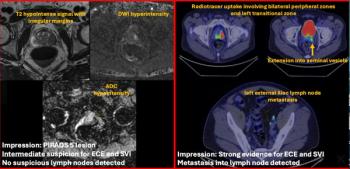
New scanners gear up for molecular imaging
Technical advances continue to make PET/CT and SPECT/CT suitable as platforms for molecular imaging. Pharmaceutical companies and specialty laboratories are developing and refining new radiopharmaceuticals. Imaging equipment manufacturers are incorporating more powerful and sensitive technology into their equipment and sophisticated reconstruction software is producing clearer images.
Technical advances continue to make PET/CT and SPECT/CT suitable as platforms for molecular imaging. Pharmaceutical companies and specialty laboratories are developing and refining new radiopharmaceuticals. Imaging equipment manufacturers are incorporating more powerful and sensitive technology into their equipment and sophisticated reconstruction software is producing clearer images.
"Essentially, the driving force in molecular imaging today is the development of new biomarkers and, most important, radiolabeled tracers," said Jonathan Frey, director of marketing in the molecular imaging division of Siemens Medical Solutions.
Two important trends are influencing radiolabeled tracer development. The first is the development of more sensitive tracers that can target and identify diseases earlier than the current generation of clinical agents. The second is the evolution of more specific tracers that result in less noise and greater conspicuity. Specificity has driven design because in addition to requiring a well-defined image, clinicians also need anatomic information that shows exactly where the observed entity is located in the body.
QUANTIFICATION WITH SPECT
Quantification assesses changes in the activity of a tumor or other tissue over time, including physiologic changes and response to therapeutic agents. To further explore quantification, Philips Medical Systems is researching compartmental modeling, a technique that takes information from animal studies and determines where a particular agent goes and in what proportion.
"It is necessary to do pharmacokinetic modeling of every agent to determine which critical organs, in addition to the target, may also pick up the therapeutic dose," said Dr. David Rollo, chief medical officer and program manager of nuclear medicine and molecular imaging at Philips. "There won't be a 'one size fits all' like there is currently with chemotherapy."
Probably the biggest limitation in quantification has been attenuation, Frey said. This is compensated by attenuation correction and is best performed with CT. The evolution of hybrid systems, along with CT attenuation techniques, has made quantification a reality for SPECT. Although attenuation correction and quantification have long been available for PET, SPECT has never been quantifiable before.
Technological advances in both detectors and reconstruction software are making PET/CT and SPECT/CT better platforms for molecular imaging. In the SPECT arena, noteworthy advances include solid-state detectors and improvements in the doping material in sodium iodide crystals, Rollo said.
"By improving detector characteristics, energy resolution can be improved, which contributes to better overall spatial resolution," he said.
Just as important are advances in reconstruction software. Philips has developed ASTONISH, a proprietary 3D reconstruction and resolution recovery software. It features advanced reconstruction algorithms for SPECT and planar imaging that improve resolution by modeling collimator characteristics and imaging depth. It also corrects for loss due to scatter and attenuation. Typical measurement capability of a nuclear medicine camera is about 1.2 cm of spatial resolution, Rollo said. With ASTONISH, that spatial resolution drops to 4.4 mm.
DETECTORS AND SOFTWARE
Improved detector material and enhanced reconstruction software are also driving enhancements in PET/
CT. PET detectors have traditionally used bismuth germinate oxide (BGO) scintillation crystals, but newer detectors use lutetium oxyorthosilicate doped with cesium (LSO) and gadolinium oxyorthosilicate doped with cesium (GSO).
"LSO has turned out to be the perfect crystal material for PET," Frey said. "It is highly suitable for capturing coincident 511-kev photons, an attribute that has taken the industry by storm. This is clearly the detector of choice and has made a big difference in improved spatial resolution and throughput."
Philips recently introduced the GEMINI TF, the first PET system to use atomic particle time measurements to deliver increased image quality and consistency. The device uses lutetium yttrium orthosilicate (LYSO) scintillator, curved photomultipliers, and Philips' proprietary TruFlight technology.
A major advance in PET/CT scanning is retrospective respiratory gating, a technology that allows physicians to use 4D imaging over time, according to Karthik Kuppusamy, general manager of molecular imaging and radiopharmacy at GE Healthcare. GE's Discovery-STE PET/CT system employs a technology called Dimension, an advanced retrospective gating CT application that analyzes and characterizes the respiration-induced motion of anatomy.
"Dimension is not about diagnosis but about driving the right therapy for the patient," Kuppusamy said.
Newsletter
Stay at the forefront of radiology with the Diagnostic Imaging newsletter, delivering the latest news, clinical insights, and imaging advancements for today’s radiologists.




























